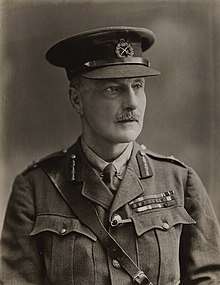Walter Campbell (British Army officer)
Lieutenant General Sir Walter Campbell, KCB, KCMG, DSO (30 July 1864 – 11 August 1936) was a British Army officer who served as Quartermaster-General to the Forces.[1]
Sir Walter Campbell | |
|---|---|
 Sir Walter Campbell, 1918 | |
| Born | 30 July 1864 County Antrim, Ireland |
| Died | 11 August 1936 (aged 72) Merstham, Surrey |
| Allegiance | |
| Service/ | |
| Years of service | 1887–1927 |
| Rank | Lieutenant General |
| Battles/wars | Second Boer War First World War |
| Awards | Knight Commander of the Order of the Bath Knight Commander of the Order of St Michael and St George Distinguished Service Order |
Early life and education
Campbell was born in County Antrim, Ireland, the son of John Campbell of Rathfern, White Abbey, Belfast. He was educated at Wellington College and Trinity College Cambridge, but left university after three years for Sandhurst when he decided upon a military career.[1]
Military career
Campbell was commissioned a second lieutenant in the Gordon Highlanders on 5 February 1887,[2] promoted to lieutenant on 5 December 1890, and saw early service with the Waziristan Field Force and the Chitral Relief Force (1895). He was promoted to captain on 11 January 1897, served in the Tirah Expeditionary Force (1897–98), and received a brevet promotion to major on 20 May 1898.[3][2] In 1899–1900 he served in the Second Boer War, for which he was appointed a Companion of the Distinguished Service Order (DSO) in November 1900.[4] He then became Brigade Major for the Highland Brigade serving in South Africa. The war ended with the Peace of Vereeniging in late May 1902, and the following month Campbell returned home in the SS Tagus, arriving at Southampton in July.[5] Following his return, he was on 19 October 1902 appointed Deputy Assistant Adjutant-General (DAAG) to the 3rd Army Corps, stationed in Ireland.[6]
He served in the First World War becoming Deputy Quartermaster-General to the Mediterranean Expeditionary Force taking part in the evacuation at Gallipoli.[7] By June 1918 he was Quartermaster-General with the Imperial Camel Corps in Jordan.[8] According to The Times, Campbell's "genius for administration made him an outstanding figure of the War."[1]
In 1918, he was sketched by artist James McBey, the official war artist to the Palestine Expeditionary Force.[9]
He was appointed Quartermaster-General to the Forces in 1923; he retired in 1927.[2]
References
- "Obituary: Lt.-Gen. Sir Walter Campbell – A Great Quartermaster-General". The Times. The Times Digital Archive. 12 August 1936. p. 12.
- Sir Walter Campbell Liddell Hart Centre for Military Archives
- Hart's army list, 1903
- "No. 27359". The London Gazette. 27 September 1901. p. 6303.
- "The Army in South Africa - Troops returning Home". The Times (36812). London. 5 July 1902. p. 8.
- "No. 27494". The London Gazette. 11 November 1902. p. 7168.
- Private papers of Lieutenant General Sir Walter Campbell KCB KCMG DSO Imperial War Museum Collection Search. Accessed 30 June 2012]
- Seven Pillars of Wisdom by T. E. Lawrence, Book 8, Chapter 95 Vintage Classics, 2008, ISBN 978-0-09-951178-6
- McBey, James General Sir Walter Campbell KCMG CB DSO, 1918 Imperial War Museum Collection Search. Accessed 30 June 2012
| Military offices | ||
|---|---|---|
| Preceded by Sir Travers Clarke |
Quartermaster-General to the Forces 1923–1927 |
Succeeded by Sir Hastings Anderson |